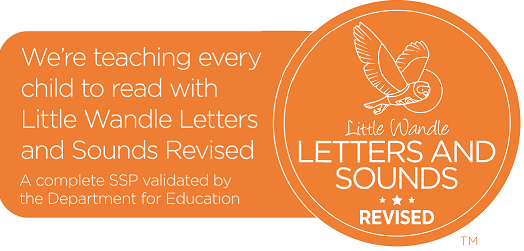Little Wandle 
📖 What is Little Wandle?
-
A nationally recognised phonics programme created by Little Sutton Primary School and the Wandle Learning Trust.
-
Built on years of research and practice, with results consistently in the top 5% across England.
-
Designed to help every child become a confident, fluent reader while also developing a lifelong love of books.
-
Focuses on synthetic phonics — teaching children to connect letters and sounds in a clear, structured way.
🛠️ How it Works
-
Children learn the 44 key sounds in English (phonemes).
-
They practise blending sounds together to read words (decoding) and segmenting sounds to spell (encoding).
-
Carefully chosen storybooks 📚 are matched to each child’s level, so they experience success and enjoyment straight away.
-
Lessons are lively, interactive, and taught in small groups tailored to children’s needs.
-
Teachers are fully trained 👩🏫 in the programme and use regular assessments to track progress.
-
Extra support is provided through catch‑up groups or one‑to‑one sessions, with progress checked every 5 weeks.
📖 Our Approach
We follow the Little Wandle Letters and Sounds Revised Phonics Programme, giving children a clear, structured way to learn sounds and words.
- ⏰ Daily Lessons – Phonics is taught every morning so children start the day focused and ready to learn.
- 🤝 Extra Support – Short daily sessions in small groups or one‑to‑one help children who need more practice.
- 📚 Reading Practice – Children read three times in school before books go home, so they feel confident sharing their reading with you.
🚀 Progression
-
📊 Every five weeks, we check each child’s phonics and reading fluency (with extra checks sooner if needed).
-
🚀 Children who need more support receive additional practice straight away.
-
📝 Year 1 children take the Phonics Screening Check in June. If they don’t pass, phonics continues in Year 2 with regular progress checks. 📝 Further Information - For more details about the Year 1 Phonics Screening Check, please see the official guidance on GOV.UK.
-
Nursery: Children build strong foundations by:
-
Listening carefully to environmental sounds 👂 (e.g. birds, cars, instruments).
-
Playing with rhythm and body percussion 👏 (clapping, stamping).
-
Spotting rhyming words 🎶 (cat, mat, bat).
-
Hearing the first sound in words (e.g. t in tin).
-
Beginning to blend and segment simple sounds (e.g. c‑a‑t → cat).
-
-
Reception onwards: Children are introduced to books linked to the sounds they are learning.
-
Phases of learning:
-
Phase 2: First simple sounds and words.
-
Phase 3: More complex sounds and digraphs.
-
Phase 4: Blending longer words.
-
Phase 5: Advanced sounds and spelling patterns.
-
🏡 Support at Home
-
After reading their book three times in school, children bring it home 🏠 to practise fluency and share with family.
-
Parents can use tips printed on the book covers to guide reading.
-
Key advice for parents:
-
🎤 Pronounce sounds clearly (no extra “uh” at the end).
-
📚 Share a story every day — bedtime reading counts!
-
💻 Explore online resources:
-
Little Wandle parent resources
-
YouTube lessons
-
-
-
Reading together builds confidence, strengthens vocabulary, and makes reading a fun family habit.
📝 Key Phonics Terms (Quick Guide)
-
Blend: Putting sounds together to read a word.
-
Segment: Splitting a word into sounds to spell.
-
Digraph: Two letters making one sound (e.g. ch, ee).
-
Trigraph: Three letters making one sound (e.g. igh).
-
Tricky Words: Words that don’t follow phonics rules (e.g. said, the).
-
High Frequency Words: Common words children learn by sight (e.g. I, you).
-
Grapheme: The written letter(s) representing a sound.
-
Phoneme: The sound itself.
👨👩👧 Parent Workshops
-
Held in the Autumn term 🍂 to help parents feel confident supporting phonics at home.
-
Staff demonstrate correct pronunciation, explain tricky words, and share practical tips.
-
Parents leave with strategies to make reading fun and effective at home.
💡 Why It Matters
-
Strong phonics skills give children the keys to unlock reading.
-
Reading fluently supports success across all subjects, from maths to science.
-
Most importantly, it helps children discover the joy of stories, imagination, and knowledge.
 |
 |



